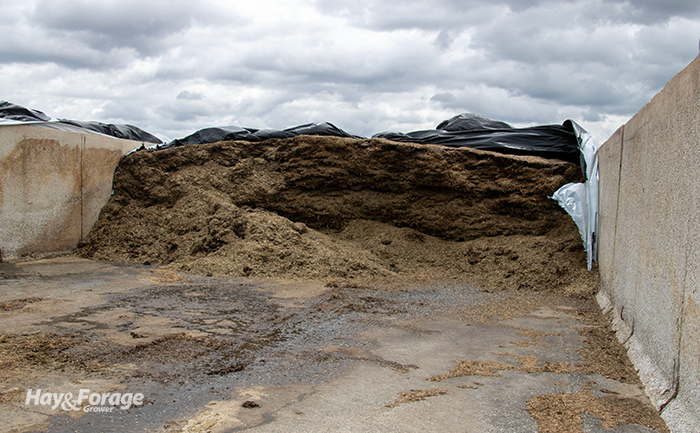
If spring green up isn’t sign enough, an echo ringing off the wall of an empty bunker silo should indicate another forage harvest season is fast approaching. Regardless of if stored forages are disappearing on schedule or a dwindling supply is cause for concern, clearing out bunker silos and silage pads creates an opportunity to inspect those structures.
In the Midwest Forage Association’s Clippings newsletter, Liz Gartman encourages farmers to take a closer look at the integrity of their silage storage structures and identify what maintenance is needed before refilling them with first-cutting forage. This includes filling cracks in concrete, cleaning drains, assessing silage bag and pile placement, and replacing accessory equipment.
“Alternatively, you may want to consider a move to a different silage storage situation altogether,” suggests Gartman, a regional crops educator with the University of Wisconsin-Madison Division of Extension.
The only direction forage quality can go after plants are harvested is down. Therefore, Gartman stresses the importance of the preliminary steps of production, including testing soil, adjusting soil fertility, and selecting seed that is best suited to your farm. From there, a timely cutting and quick hauling back to the storage site are necessary to secure the highest forage quality possible before it is put into a bunker silo, pile, or bag.
“All of this hard work can be negated by using silage structures that fail to preserve the crop or allow for spoilage or additional contamination,” Gartman says. Failure to preserve the crop can be attributed to oxygen, which can penetrate cracked concrete and ripped plastic. Poor feedout practices can also reintroduce oxygen to stored forage, which can result in secondary fermentation and spoilage.
With that said, Gartman acknowledges that different storage structures warrant different maintenance protocols. No type of storage is without its challenges, but before refilling any structure, she recommends removing all remaining feed, especially if spoiled forage remains. She also provides the following reminders.
Bunker silos
• Inspect walls, joints, and floors for cracks. Patch cracks or seal them with plastic or masonry paint.
• Inspect and clean drains so seepage flows away from the silage pile and toward a designated area.
• Line the bunker floor and walls with plastic to create a seal before refilling it. Avoid damaging the plastic while packing forage.
• Use caution to avoid tearing or damaging plastic at feedout.
Silage bags and piles
• Avoid putting bags and piles in areas that are highly trafficked, poorly drained, or accessible to wildlife.
• Place bags on a firm base such as concrete or packed limestone to limit contamination from soil or mud.
• Ensure bags and piles are positioned on a slope to encourage water drainage away from the feedout face.
• Inspect bags and piles regularly to identify bird, rodent, or weather damage, repairing any holes as soon as possible.
Tower silos
• Note areas in the silo where feed spoilage consistently occurs.
• Inspect cracked walls, damaged doors, and ladders, cages, and chutes in need of repair.
• Check silo seals and repair unloaders, cables, and pulleys if necessary.
• Have older tower silos professionally inspected on a regular basis.
Make safety a top priority during inspections. Gartman recommends wearing appropriate personal protective equipment (PPE), using a harness, and working in pairs. Ensure all equipment is turned off and cannot be accidentally turned back on. Additionally, if there is still forage in bunkers or piles, she instructs farmers to maintain a distance of at least three times the height of the face to avoid avalanches.
“The adage goes, an ounce of prevention is worth a pound of cure, and that certainly applies to ensuring our high-quality forage is stored in a high-quality structure,” Gartman asserts.

